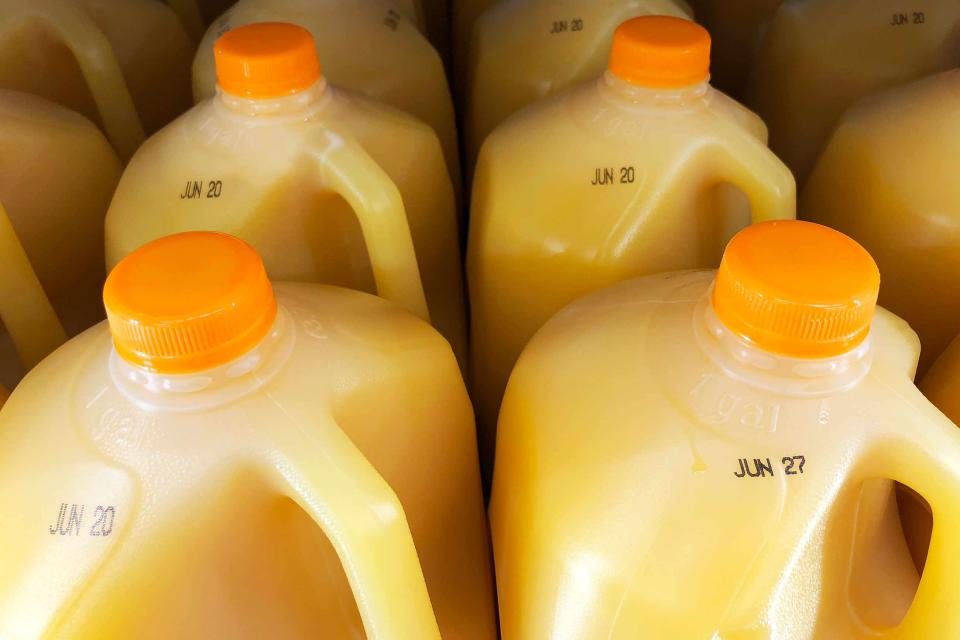How to Understand Food Expiration Dates
Read this before you throw out your milk.

Getty Images
We’ve all had that moment while staring at a carton of eggs, a tub of yogurt, or a can of beans, wondering if it’s safe to eat even past the date stamped on the bottom of the package. It can be difficult to calculate if something is "safe" to consume, yet it is one of the most important decisions you make when eating perishable products. With that dilemma in mind, we put together this guide on food safety to explain food quality dating with the help of Argyris K. Magoulas, a food safety specialist of USDA’s Meat and Poultry Hotline. He explained that dates on foods are not necessarily as strict as they may seem. Here’s what you need to know.
What is Food Product Dating?
Food manufacturers date their goods as a way to help both consumers and retailers decide when to purchase and consume food at its highest quality – not necessarily when products and goods are “safe” to consume.
The exception is infant formula, which is required to have a “Use-By” date that must be consumed before this date to ensure the quantity of nutrients is the same as specified on the label, as specified under federal regulations.
:The Best Food Storage Containers According to Our Tests
Open Dating vs. Closed Dating
Magoulas says that there are two types of dating that may appear on a product label – open and closed dating. A product's "open date" is a calendar date applied by the manufacturer or retailer indicating the item’s “peak quality” time. This is generally found in the form of a “Best if Used By” date. Open dating labels can be found on the majority of packaged foods, including meat, poultry, eggs, and dairy products. “In addition to providing consumers with the estimated period of time for which the product will be at its best quality, the calendar date is also used to determine how long the product should be displayed for sale in the store,” Magoulas says.
Closed dating is used on shelf-stable products like on cans and boxes, and refers to “codes that identify the date of the production of their products, so consumers and manufacturers can choose to have food to its highest quality,” says Magoulas.
This often appears as codes that consist of a series of letters and/or numbers applied by manufacturers to identify the date and time of production, appearing as MMDDYY. For example, "112922" would be read as November 29, 2022.
What Date-Labeling Phrases are Used?
In the U.S., there isn't a uniform or universally-accepted way to describe quality dates on food labels. However, according to the USDA, there are a few commonly-used phrases that are helpful to know and understand:
A "Best if Used By/Before" date lets you know when the product will be at its peak freshness, which is not necessarily an indication of safety.
A "Sell-By" date is just a way for the store to keep track of inventory, which can be irrelevant to the consumer.
The "Use-By" date is the last date for using the product while it's at peak quality. It's not a safety date, unless it's for infant formula.
The "Freeze-By" date tells you when a product should be frozen to preserve its quality, making it not a safety date.
Magoulas also recommends consumers review the USDA’s Food Product Dating sheet, which goes a bit more in-depth on safety and expiration dates.
:How to Share Food with Other People in the Least Gross Way Possible, According to an Expert
Focus on Storage Time, Not Dates
Most importantly, because there are few federal regulations for product dating, Magoulas recommends following storage times, rather than following open dates.
In regards to perishability, Magoulas says that after purchase, cartoned eggs can be safely kept for 3 to 5 weeks refrigerated (40°F or less); yogurt for 1 to 2 weeks in the refrigerator; cuts of red meat 3 to 5 days and ground meat just 1 to 2 days in the refrigerator; all raw poultry (bird, parts or ground) just 1 to 2 days in the refrigerator. “These may seem conservative but they are good to follow. Food safety is a high priority here,” Magouals stresses.
As for commercially purchased canned goods, the USDA says that foods with a high acidity, like tomatoes and some fruits will keep their best quality for up to 18 months. On the other hand, low acidity foods like meat and vegetables can last 2 to 5 years, if kept in good condition (no dents, rusting, or swelling in the can).
It can be a lot to remember all of these dates, with so many different types of produce and goods on the market. As a rule, avoid buying products that are past their sell/use/best-buy date. Magoulas recommends using FoodKeeper to help you understand how to best store your food, beverage and produce.
“FoodKeeper helps you maximize the freshness and quality of items. By using this feature you will be able to keep items fresh longer than if they were not stored properly. You can view and search by category or even by individual item,” says Magoulas.
:Americans Still Don't Understand the Risks of Eating Raw Flour, Research Reveals
Keeping food safe and preventing food poisoning starts with handling food properly once purchased. Foodkeeper shares information on all types of food products and produce. For example, they share that butter can:
Be left at room temperature for 1 to 2 days.
Be refrigerated from the date of purchase for 1 to 2 months.
Be frozen from the date of purchase for 6 to 9 months.
FoodKeeper is also available as a mobile application for Android and Apple devices.
Consumers can also call the USDA’s Meat and Poultry Hotline and speak with a food safety specialist, toll free: 1-888-674-6854 between 10 a.m. and 6 p.m. EST to answer all food safety, storage and quality concerns.

